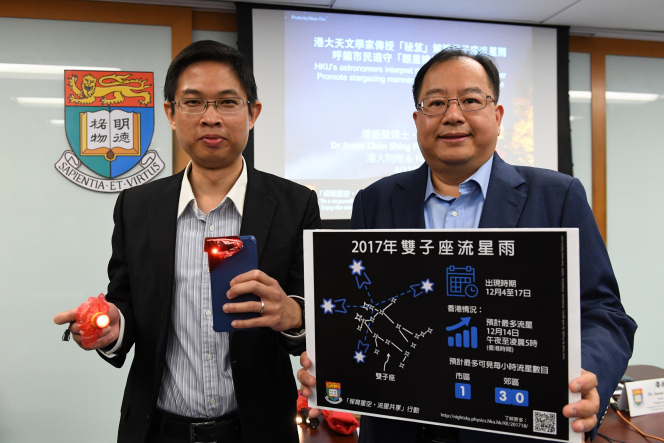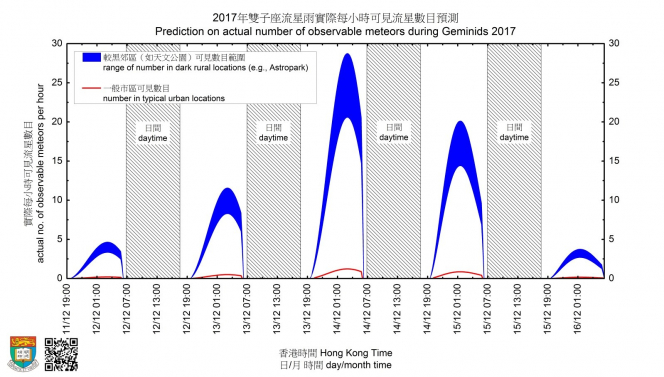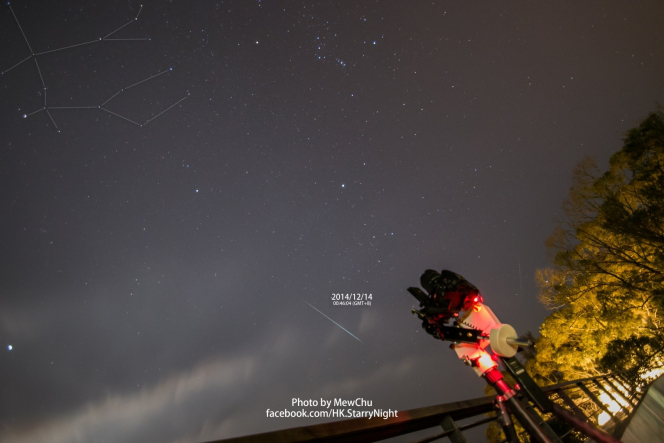Media
HKU’s astronomers interpret the Geminid Meteor Shower and
promote stargazing manners and dark sky conservation
04 Dec 2017
The meteor shower with the best observation conditions this year, the Geminid Meteor Shower, will occur from today to December 17. The observation conditions of the various meteor showers each year depend on a multitude of natural and artificial factors. HKU astronomers have determined that the best time to observe the Geminid Meteor Shower this year in the Hong Kong territory will be midnight to 5 am on December 14. There may be 20-30 meteors per hour if you’re watching at a dark rural location with a wide field-of-view during that period.
When the Earth sweeps past regions of meteoroids left behind from comets or asteroids, a meteor shower will appear as if it originates from a particular point (the radiant) in the sky. Dr Jason Pun Chun-shing, an astronomer in HKU Physics Department and the Principle Investigator of the Hong Kong Night Sky Brightness Monitoring Network explains: “The actual number of meteors observable in the night sky during any particular meteor shower is affected by many factors, including various natural factors such as the geographical location of the observing site and its light pollution condition, the activity of the shower, the peaking time of the meteor shower activities, the location of the radiant point in the sky, moon phase, the amount of cloud in the sky and the field-of-view of the observation location. At the same time, human factors including the observer’s eyesight and experience may also affect what can be seen. In terms of anthropogenic factors, the extent of light pollution in the observing location is of foremost importance in Hong Kong.”
Regarding the prediction that the Zenithal Hourly Rate (ZHR) for this year’s Geminid Meteor Shower being 120 per hour, Dr Pun explains that this figure is an ideal maximum, which assumes the observer has totally dark-adapted eyes, the radiant is directly up the zenith during the peak hour, and the observing site has an unobstructed field-of-view open without moonlight and light pollution. In fact, this assumed maximum will not realistically take place in Hong Kong. Part of the reason is that the peak activity of this Shower will occur during daytime in Hong Kong and the radiant of this shower is not along the zenith direction. Therefore even in a location with zero light pollution, the number of meteors observable in Hong Kong will only be around 70.
Light Pollution Dampens the Meteor Shower
The HKU Physics Department has been conducting comprehensive research on the light pollution conditions all around Hong Kong for over a decade through the Hong Kong Night Sky Brightness Monitoring Network. Results from the Monitoring Network clearly indicate light pollution is serious in Hong Kong, and the actual number of meteors observable is closely related to the level of light pollution: the more serious the light pollution is, the smaller the numbers of stars and meteors observable. The measured night sky brightness data collected also allows for more realistic estimates of the number of meteors observable.
HKU astronomer and Project Manager of the Hong Kong Night Sky Brightness Monitoring Network, Dr So Chu-wing computes the number of meteors observable in Hong Kong based on the light pollution data collected from the Monitoring Network and the meteor shower model of NASA scientist Dr Peter Jenniskens. Based on the calculations, if local weather permits, the number of meteors observable from this Geminid Meteor Shower in a dark location with a wide field-of-view, such as the Astropark in Sai Kung, could possibly reach 20-30 per hour during the best observation hours of between midnight and 5 am on December 14, while the number for an urban site can be no more than 1 per hour during the same period! This implies the severe light pollution in Hong Kong leads to a drop of over 50% of the actual number of meteors observable in most places, and over 90% in urban locations.
Infographics on dark sky preservation: adopting proper stargazing manner when viewing the shower
The Department of Physics of HKU has prepared a series of educational infographics for non-experts on meteor showers and dark sky preservation and it is available for free at the public website:
http://nightsky.physics.hku.hk/KE/201718/ . The infographics introduce tips and proper stargazing manners on viewing the Shower:
Tips for viewing the Meteor Shower:
- Pay attention to the weather conditions
- Watch during the best observation hours (midnight - 5 am of December 14)
- Stay away from locations with severe light pollution
- Choose a location with a wide field-of-view
× DO NOT use a telescope
Proper stargazing manners:
- Use torches with red light only
× DO NOT use powerful lighting or use flash photography
× DO NOT leave behind rubbish, disturb animals and plants, or destroy natural landscapes
On the usage of red light torches instead of normal torches, Dr So explains, “Strong lighting leads to light pollution and makes dimmer stars and meteors less visible. Red light is better because it won’t affect our night vision as much, giving us a better chance to see more meteors.” A red light torch can be easily prepared by covering a regular torch by layers of red cellophane, cloth or plastic bag.
“Be a responsible stargazer • Enjoy the meteor shower” Campaign
Both meteor showers and starry skies are valuable natural wonders, but they are slowly disappearing due to severe light pollution. Light pollution not only deprives us of the starry night skies, it also indicates a waste of electric energy and damages both the natural and living environment. It is therefore of utmost importance to reduce light pollution and protect our dark skies by proper usage of outdoor lighting.
To promote dark sky preservation, HKU Physics is launching the “Be a responsible stargazer • Enjoy the meteor shower” Campaign to encourage the adoption of proper stargazing manners, and to promote reducing light pollution. From now until January 31, 2018, members of the public can post photos of themselves enjoying the night sky with proper stargazing manners, or photos showing lighting fixtures which causes / reduces light pollution (with location) to Facebook with hashtags “#ResponsibleStargazer #MeteorShower”. The Campaign will select the best posts and showcase them during the Hong Kong Science Festival organized by the Hong Kong Science Museum in March 2018. This project is supported by the HKU Knowledge Exchange Fund.
For more about the “Be a responsible stargazer • Enjoy the meteor shower” Campaign, please go to http://nightsky.physics.hku.hk/KE/201718.
Photos can be obtained via http://www.scifac.hku.hk/news/media?page=1.
For the powerpoint slides presented in this press briefing, please click here.
For press enquiry, please contact:
Miss Rhea Leung, Manager (Media) Communications and Public Affairs Office at 2857 8555 / 9022 7446 or by email at rhea.leung@hku.hk, or Ms Cindy Chan, Senior Communication Manager of Faculty of Science at 3917 5286 / 6703 0212 or by email at cindycst@hku.hk, or Dr Jason Chun Shing Pun, HKU Department of Physics at 2859-1962 or by email at jcspun@hku.hk, or Dr Chu-wing So, HKU Department of Physics by email at socw@connect.hku.hk.
More Information
About meteors and meteor showers
A meteoroid is a small body made of rock or metal and an enormous number of them exist in our Solar System. When a meteoroid enters the Earth's atmosphere with a speed of tens of kilometers per second, the resulting excessive heat from the air friction will cause these meteoroids and the surrounding atmosphere to glow, creating a bright streak of light in the sky called a meteor.
Some meteoroids originated from remnants of comets or asteroids. When the orbiting Earth sweeps past regions which are densely populated with meteoroids, multiple meteors will appear in the night sky as if they are radiating from a single point in the sky (known as a “radiant”), forming a meteor shower. Meteor showers are named by the constellation where the radiant is located.
The yearly orbital motion of the Earth implies that it will sweep past certain groups of meteoroids around the same time every year, thus explaining why meteor showers reappear roughly at the same time each year. There are several major annual meteor showers, including the Perseids in August, the Orionids in October, the Leonids in November and the Geminids in December. The numbers of observable meteors of different meteor showers are different each year, depending on various factors, such as the activity of the shower in that particular year, timing of the peak, and moon phase, etc.
About Geminid Meteor Shower
The Geminid Meteor Shower is one of the major meteor showers. Its radiant is located at the constellation Gemini. Its meteoroids are related to the asteroid named 3200 Phaethon. The peak of Geminids occurs on December 14 with a Zenithal Hourly Rate of 120.
About “Zenithal Hourly Rate” (ZHR)
"Zenithal Hourly Rate”, or ZHR in short, is the hourly number of observable meteors of a particular meteor shower. To achieve this number, an observer with totally dark-adapted eyes under idealized observation conditions are required. The conditions include that the radiant has to be directly up the zenith, and the observing site has an unobstructed field-of-view open without moonlight and light pollution. Thus the actual number observable will always be smaller than this idealized number of ZHR. Since the peak activity of the Geminids this year is expected to occur at daytime on December 14 (~2:30 pm) in Hong Kong, the actual number of observable meteors at night would be further reduced.
The actual number of observable meteors depends on a number of factors, including the light pollution conditions and the geographic location of the observing site, activity of the shower, timing of the peak, altitude of the radiant, observer’s eyesight and experience, moon phase, cloud amount, and the field-of-view, etc. By incorporating the light pollution data from the Hong Kong Night Sky Brightness Monitoring Network, HKU astronomers have calculated the number of observable meteors per hour in this year’s Geminid Meteor Shower under general weather conditions to be as follows:
|
HK Time |
Dec 13, |
Dec 14, |
Dec 14, |
Dec 15, |
|
Darker rural area (e.g., Astropark, Tai Au Mun) |
about 6 - 10 |
about 20 - 30 |
about 7 - 10 |
about 14 - 20 |
|
Typical urban area |
0 |
about 0 - 1 |
0 |
0 |
About Light Pollution
Light Pollution is a form of environmental degradation. The wasteful light from outdoor manmade light sources emitted directly upwards or reflected from the ground can brighten the sky through scattering by clouds, fog, and pollutants like suspended particulates in the atmosphere. Results from the HKU’s Hong Kong Night Sky Brightness Monitoring Network indicates that the urban night sky in Hong Kong was around 10 times brighter than that of the rural night sky. Recently, local astronomy educator Mr Ricky Leung measured the light pollution conditions in some stargazing sites, such as Astropark and Tai Au Mun. It was found that the light pollution level at these sites exceeded the international standard of dark sky without light pollution by at least 4.5 to 6 times. The problem of light pollution exists even in rural regions. Light pollution not only deprives us of the starry night skies, it also indicates a waste of electric energy and damages both the natural environment and our living environment.
Appendix
|
Prediction on the number of observable meteors during Geminids 2017. The blue regions show the expected range of meteors per hour in a dark rural location (e.g., Astropark), while the red line represents the expected number in a typical urban location. |
|
The relation between the number of observable meteors during Geminids 2017 and the light pollution condition of observing site. The plot shows the prediction for December 14, 2017 at 3 am, the best observing time. The number of meteors observable in Hong Kong will be around 70 per hour in a site with no light pollution, but it drops to ~20 - 30 (blue region) for a dark rural location (e.g., Astropark) and further to ~ 0 - 1 for a typical urban location (red). |
|
The Geminid Meteor Shower in 2014. Photo credit: Mr Mew Chu |




